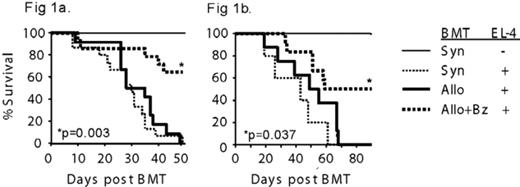Abstract
Benzodiazepine (Bz)-423 is a benzodiazepine derivative that targets activated lymphocytes through the mitochondrial F1F0-ATPase, causing loss of mitochondrial membrane potential and apoptosis without affecting resting lymphocytes. We tested Bz-423 in a non-irradiated B6-Ly5.2 → B6D2F1 model of graft-versus-host disease (GVHD) where donor cells were labeled with CFSE to discriminate 3 days after injection between activated (CFSElo) and unactivated (CFSEhi) Ly5.2+ donor or host Ly5.1+ lymphocytes. Compared to controls, Bz-423 caused loss of mitochondrial membrane polarization within 6h of delivery as measured by 3,3’-dihexyloxacarbocyanine iodide (DiOC6(3)) staining in both activated donor CD4+ (12.6% vs 3.3%, p=0.002) and activated CD8+ (12.9% vs 3.0%, p<0.001) T cells but not in unactivated donor or host cells. Loss of mitochondrial membrane potential was followed by selective apoptosis (Annexin-V+) of donor CD4+ (34.9% vs 16.5%, p=0.04) and CD8+ (29.8% vs 12.2%, p=0.03) T cells. Intraperitoneal injection of 60mg/kg Bz-423 3 times weekly beginning 7d after GVHD induction significantly reduced mortality (50% vs 100%, p<0.02). We next used Bz-423 in a miHA-disparate, CD8+ T cell-mediated model of GVHD (C3H.SW → B6) in which B6 hosts received 9 Gy of TBI followed by injection of 5x106 C3H.SW BM cells and 4x106 T cells. We initiated Bz-423 injections 7d after BMT, when GVHD was already established. The drug significantly reduced GVHD clinical scores and improved survival compared to controls (74% vs 29%, p≤0.02). Bz-423 also significantly reduced quantitative GVHD histologic damage indices in the liver (3.6 vs 11.2, p<0.03) and the GI tract (7.0 vs 15.8, p<0.02). Complete donor engraftment was observed in all animals. Bz-423 reduced IFN-γ, a known mediator of GVHD, in the serum (8.4 vs 21.7 pg/ml, p<0.03) and decreased IFN-γ+CD8+ effector spleen T cells (0.64x105 vs 2.2x105, p=0.008), but did not impair the lysis of tumor targets by CD8+ T cells ex vivo. We tested Bz-423 next in a graft-versus-leukemia (GVL) model where EL-4 lymphoma cells (4x103) that are syngeneic to B6 recipients were injected on the day of BMT. No recipients of syngeneic BMT survived EL-4 challenge (0/12) and no untreated allogeneic BMT survived GVHD (0/12) but 9/14 (64%) of Bz-423 treated allogeneic recipients were alive on day 50 without evidence of lymphoma (p=0.003, Fig 1a). We confirmed the effectiveness of Bz-423 in a third model of GVHD to MHC differences (Balb/c → B6) where again Bz-423 significantly reduced all clinical, biochemical and histologic GVHD parameters and improved day 60 survival (58% vs 8%, p<0.002). Bz-423 also preserved GVL effects in this model where 50% of recipients survived without evidence of EL-4 lymphoma compared to 0% of controls (p<0.04, Fig 1b). We conclude that Bz-423, a first-in-class compound that selectively inhibits mitochondrial respiration and causes apoptosis of activated lymphocytes, can reverse experimental GVHD while preserving beneficial GVL effects.
Author notes
Disclosure:Consultancy: Lycera (a biotech start-up company). Ownership Interests: Stock shares in Lycera. Research Funding: Lycera. Membership Information: Member of SAB, Lycera.


This feature is available to Subscribers Only
Sign In or Create an Account Close Modal